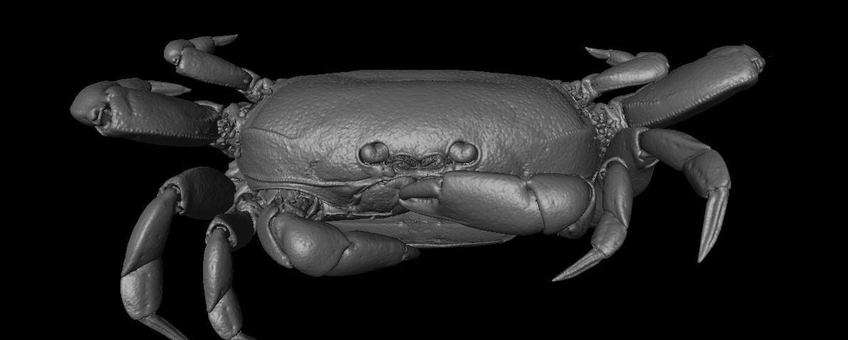
New insights in the world of mussel-invading crabs
Naturalis Biodiversity CenterWhile a plate full of mussels is an appetizing sight for a lot of people, there might be more on their plate than they would think beforehand. In addition to the aggregations of barnacles which you sometimes see on the shells, there are also other crustaceans which get into the shells. The pea crabs (family Pinnotheridae) get their name from their nail-sized bodies and their round shape. You can find them in all the world’s oceans, living parasitically inside bivalves such as oysters and mussels.
The crabs you find in your dinner are most of the time only females: female pea crabs have evolved to be soft and have an enlarged abdomen, used to carry the eggs. This, together with their feeble walking legs, resulted in them not being able to walk around anymore. In other words, female pea crabs cannot leave their host anymore. Male pea crabs, however, are much smaller and hop in and out hosts to mate with the waiting females. The male crabs are much harder and possess swimming hairs on their legs.
3D-CT-scan of a Pinnotheres crab (Source: Werner de Gier)
Squirt
Although the bivalve-inhabiting European pea crab species are fairly well known, the family consists of more than three hundred recognized species, living in various hosts in all the world’s oceans. As a few examples: pea crabs have been found in the soft parts of urchins, sea squirts and snails; in the holes and tubes of sand-inhabiting worms and lobsters; and inside the frontal and back-end of sea cucumbers. The body-modifications of pea crabs to live in such extraordinary microhabitats have scarcely been mentioned and figured in the two hundred years’ worth of literature, but they were never reviewed in detail.
 Werner de Gier, PhD Candidate at Naturalis Biodiversity Center (Leiden), together with co-author Carola Becker (Humboldt universität, Berlin), found new insights in the evolutionary adaptations of pea crabs, by studying all the available literature.
Werner de Gier, PhD Candidate at Naturalis Biodiversity Center (Leiden), together with co-author Carola Becker (Humboldt universität, Berlin), found new insights in the evolutionary adaptations of pea crabs, by studying all the available literature.
Questions arose like 'how can pea crabs be so successful in their symbiosis?' In addition to the literature, CT-scans were made to visualise the adaptations in the pea crabs from the collection. A few examples: pea crabs living on sea urchins and the related sand dollars have a relatively hard carapace and bear 'forked' ends on the nails of their walking legs, possibly used for walking around on their spiny hosts. The sea-cucumber inhabiting pea crabs are often covered in hairs, possibly a way to camouflage themselves from the hosts’ senses. Pea crabs living in flattened shells often bear asymmetrical legs, the crabs are thought to use their long legs to 'reel in' the hosts’ mucus.
Ornaments
As is often the case in review works, every discovery led to more questions: a few species of pea crabs possess strange ornaments on their carapaces. “The functions of these ornamentations are unknown as for now, but using the CT-scans and 3D models we can digitally cut the specimen in slices. Doing this, we can not only analyse the external surface, but also the internal anatomy of the crab!”, says De Gier. The literature review, including the 3D models and a list of all known crab-host relationships was published in the scientific journal
More information
Text, pictures and video: Werner de Gier, Naturalis Biodiversity Center
